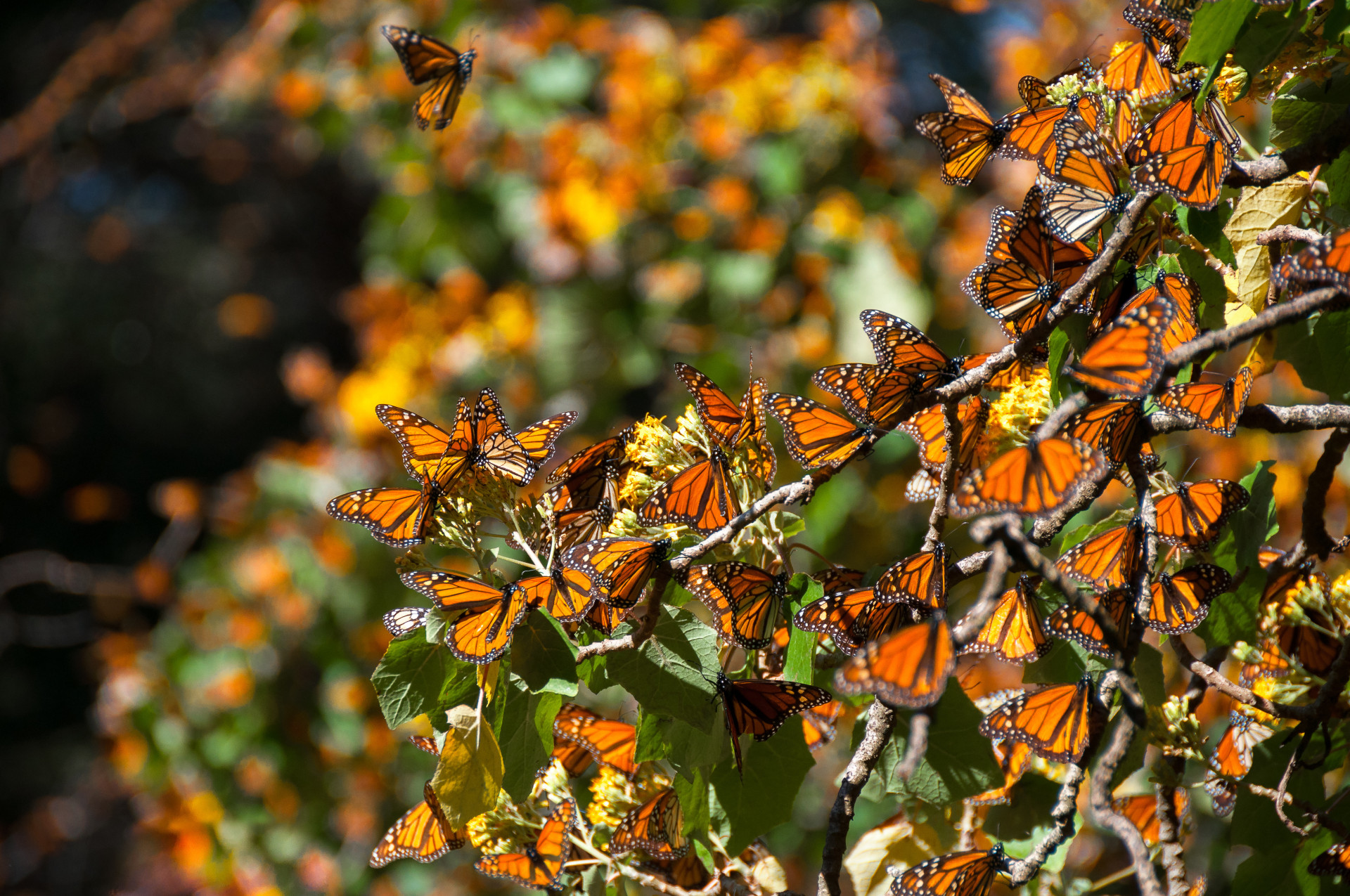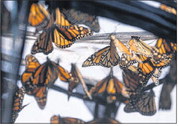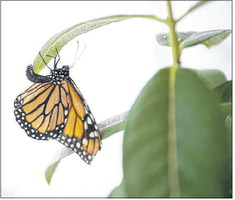
More Monarchs Wintered in Mexico
Apr 03, 2025
The number of monarch butterflies that spent the winter in Mexico doubled this year, giving hope for a species that has faced decline in recent decades. And while conservationists welcome that news, they warn those numbers still lag and more work is needed.

The following article was published in the Cedar Rapids Gazette on Thursday, March 20, 2025. Reprinted here with permission.
More monarchs spent the winter in Mexico
But conservation still needed to improve endangered population
By Olivia Cohen, The Gazette
The number of monarch butterflies that spent the winter in Mexico doubled this year, giving hope for a species that has faced decline in recent decades. And while conservationists welcome that news, they warn those numbers still lag and more work is needed.
Monarchs occupied about 4.4 acres over the 2024-2025 winter season in Mexico, up from 2.2 acres the previous winter, nearly doubling their population.
The overwintering population is determined by measuring the area of the trees the butterflies congregate in during the winter.
Experts have established a goal of 15 acres that the monarchs should occupy when they fly south for the winter — a number that hasn’t been reached since 2018.
The eastern monarch’s total population is a fraction of what it was in the 1990s, when some overwintering numbers topped 30 and 40 acres.
Augie Bergstrom, manager of the monarch research station at the Marion nonprofit Monarch Research Project, said he is happy that the numbers rose, but more conservation still is needed.
“I wouldn’t necessarily celebrate it,” he said of this winter’s numbers. “In the last decade, we are far below the numbers we saw the previous 20 years. We need to continue to do everything we can.”
The report on this winter’s overwintering population comes several months after U.S. officials moved to add the monarch butterfly to the endangered species list in December. If the rule, which was proposed by the U.S. Fish and Wildlife Service, is finalized, the butterfly would become one of the most widespread species ever protected under law.
WHY DID THE POPULATION DOUBLE?
Bergstrom said that the population likely doubled due to favorable weather conditions while the butterflies were migrating.

Monarch Research Project station manager Augie Bergstrom releases monarch butterflies during Monarch Fest last July at Indian Creek Nature Center in Cedar Rapids. (Savannah Blake/The Gazette)

Monarch butterflies flitter in an enclosure before being released during Monarch Fest at Indian Creek Nature Center in southeast Cedar Rapids on July 15, 2023. (Jim Slosiarek/The Gazette)
Butterflies/ East Iowans can help save species
“There weren’t any serious weather events (and) there wasn’t serious drought like there was the last year or two,” he said. “So those favorable conditions, it gave us those wintering numbers.”
Bergstrom said favorable conditions for the monarch’s migration include some moisture and some warmth, ideally between 70 and 85 degrees Fahrenheit.
“I think if conditions are favorable, as a community we have something to celebrate because I think we are planting more natives,” Bergstrom said. “But if we compare that to what a true native habitat looks like, we’re nothing near it.”
Nathan Brockman, director of entomology at Reiman Gardens at Iowa State University, said he also believes warm temperatures played a role in the uptick in overwintering acres.
“But it’s kind of tricky,” he said. “Yes, this year’s count in Mexico is almost double of what last year’s number counts were. But if you look at the last 10 years, this year’s count is the third lowest over the last 10 years from back to 2015.”
And, just because the overwintering count was higher this year, the population still could change as the butterflies return north for the summer.
Brockman said several years ago, an overwintering count found stronger monarch numbers, but an unseasonably late frost happened as the insects were migrating north and a portion of the population was killed off.
“So any time one of these counts come out, until we get through the rest of spring and the butterflies are flying north, I always worry that we’re going to have another one of those really unseasonable freezes down there,” he said.
Bergstrom said southern states are currently in ranging drought conditions, and that could mean fewer plant options for monarchs to stop and refuel on their journey north.
“We won’t obviously know what the effects of this is until we get a solid number this coming year back in Mexico, but you know you need favorable conditions on the way down and on the way back up,” Bergstrom said. “Not to paint a gloom picture, but they may be doubled down there, but they may not be doubled on their wayback up.”
HOW IS THE WESTERN MONARCH POPULATION?
Eastern monarchs — which breed east of the Rocky Mountains — typically migrate to Mexico between August and October, and head back north in March.
Western monarchs breed west of the Rocky Mountains, and spend their winters along the California coastline.
Mykayla Hagaman, program specialist with the Iowa Monarch Conservation Consortium, said the only difference between the eastern and western monarchs is their range. But both types of monarchs face the same threats, population declines, habitat loss and vulnerability to weather fluctuations. While eastern monarchs seem to have rebounded a bit this year, the overwintering count showed a decrease in western monarchs’ population. Researchers recorded the second-lowest overwintering numbers with just 9,119 butterflies counted.
MORE CONSERVATION IS NEEDED
Although this year there was an increase in population, experts say more conservation still is needed to preserve the endangered insect.
Hagaman said the key to preserving the monarch and helping the butterfly species boost their population is establishing stronger habitats
for them. “One of the major causes for decline with monarchs is habitat loss. Habitat establishment is a key thing that we can do to help with monarch conservation and anyone can really help do this, no matter how much land you have,” Hagaman said.
Hagaman said this is particularly important when planting native milkweed and native nectarine plants.
“Monarchs lay their eggs only on milkweed plants and caterpillars only eat milkweed plants,” she said. “So, we really need to be planting native milkweed plants to help provide food resources for the caterpillars.”
Adult monarchs feed on nectar plants.
“We also need to make sure that we’re providing native nectar resources so that the adult monarchs can continue their migration and continue the cycle of laying eggs and caterpillars and back to adults and continue that reproductive cycle.”
Bergstrom said Linn County residents who want to plant native species to help the monarch population can do so through the Monarch Research Project.
He said that people can buy milkweed plugs through the nonprofit and can obtain native seeds free of charge.
The organization will host its annual Orange Alert event May 18. At the event attendees can learn how to create a backyard pollinator garden to support the butterfly population.
Registration for Monarch Research’s Native Oasis program also is open. The program works by helping homeowners in Cedar Rapids, Marion and Hiawatha incorporate native plants into their gardens.
Olivia Cohen covers energy and environment for The Gazette and is a corps member with Report for America, a national service program that places journalists in local newsrooms to report on under-covered issues.

Volunteer Nate Doig, 14, trims milkweed plants at the Monarch Research Station in Linn County on June 3. (Nick Rohlman/The Gazette)

A monarch butterfly lays an egg on a lab-grown milkweed plant at the Monarch Research Group on Aug. 10, 2016. (The Gazette)